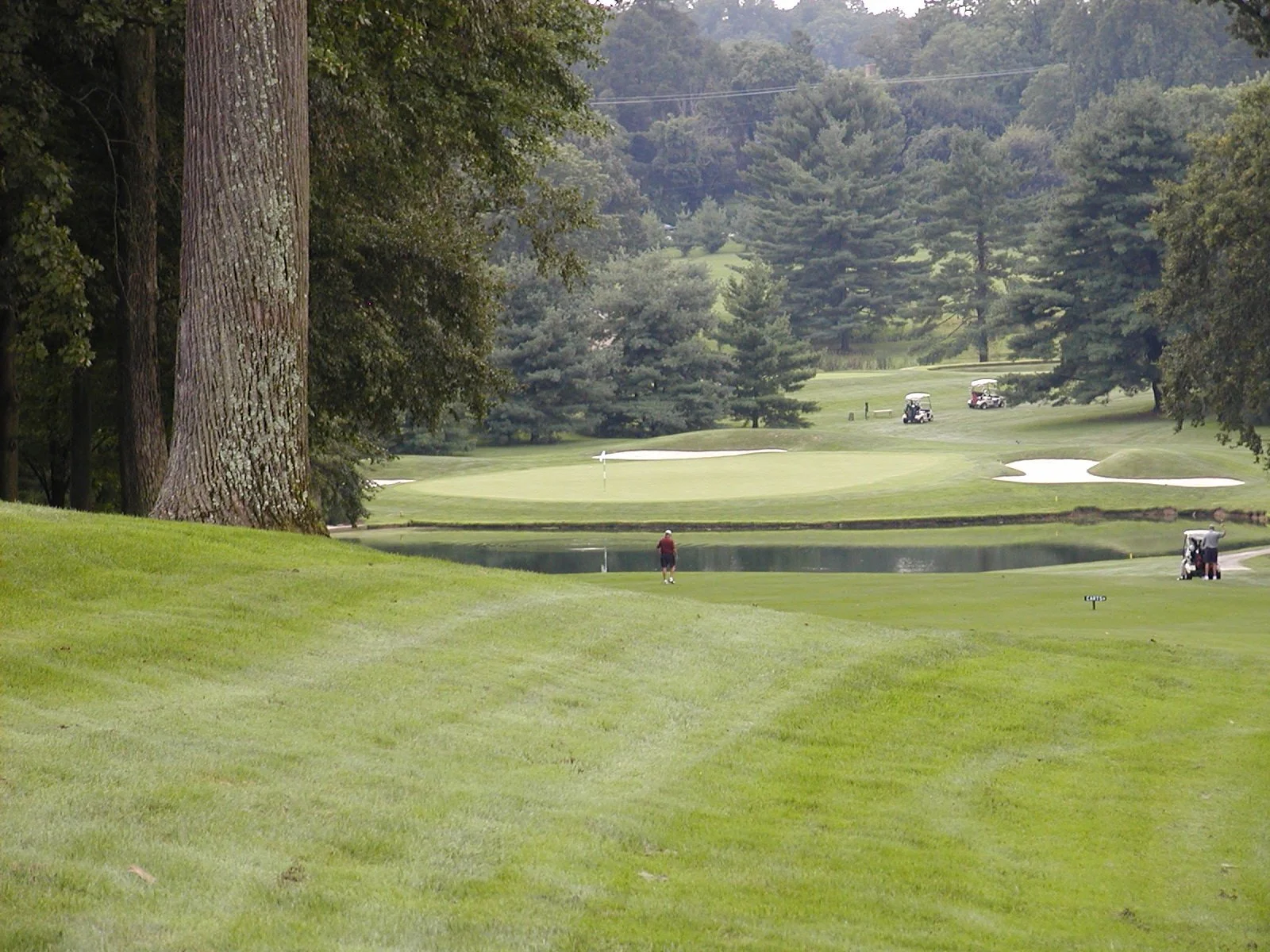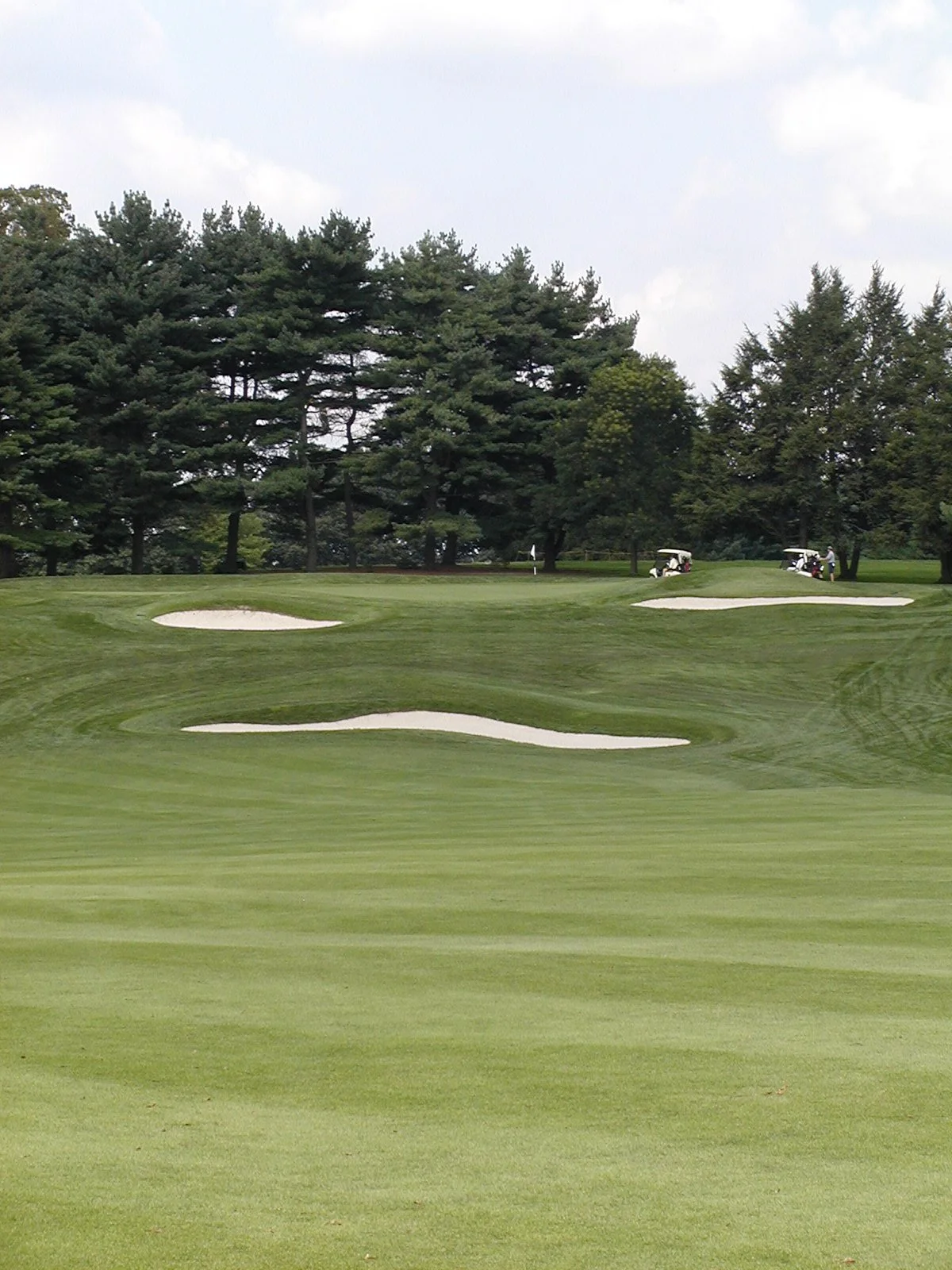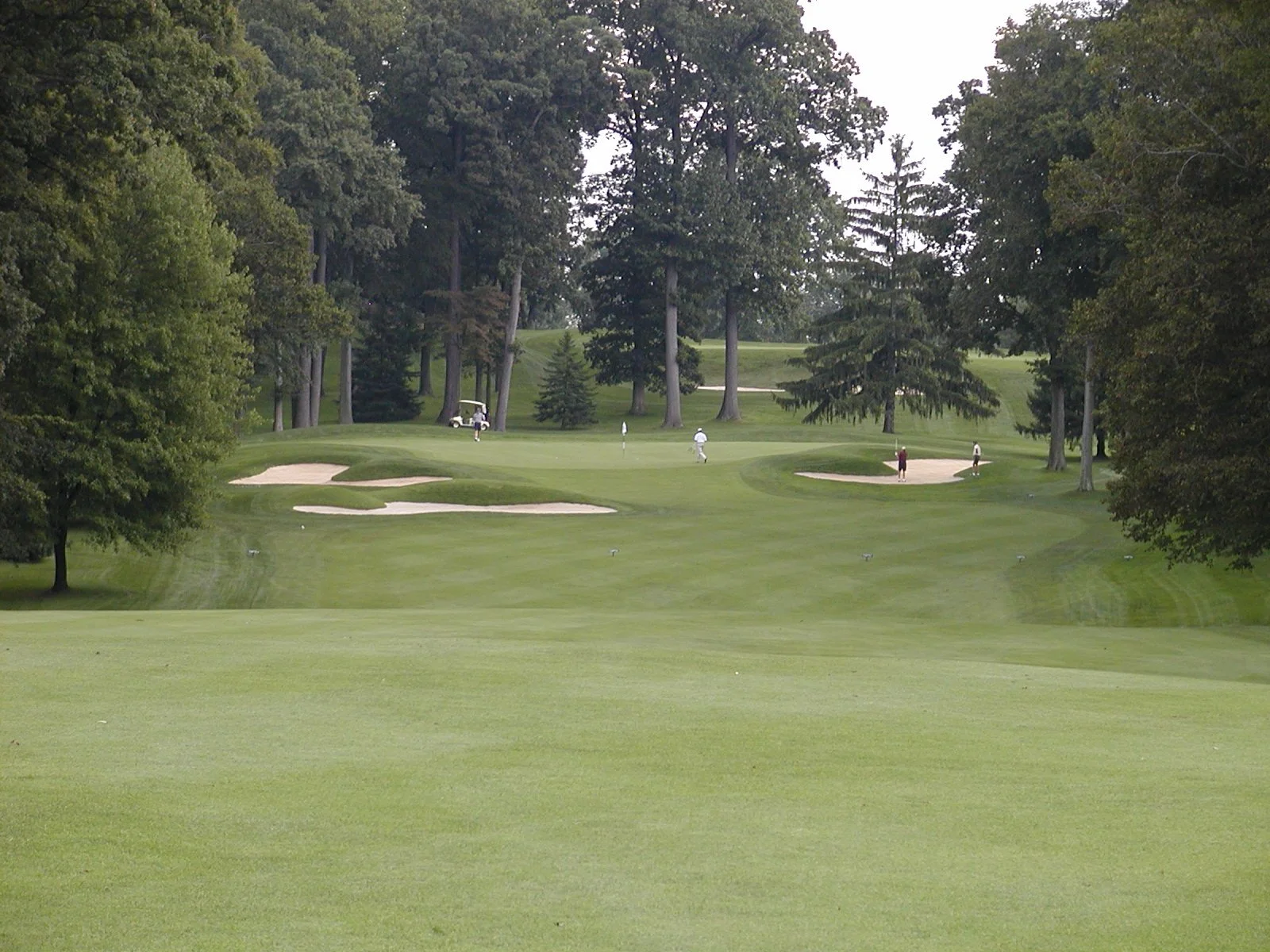WILMINGTON COUNTRY CLUB (SOUTH COURSE)
Course Architect: Robert Trent Jones Sr, Andrew Green (2021 - renovation)
Year Opened: 1959, Incorporated (1901)
Location: Wilmington, Delaware
Slope: 142. Rating: 75.9
Par: 71
Yardage: 7,534
Hole-by-Hole: 1 - Par 4 444 Yds 10 - Par 4 437 Yds
2 - Par 4 430 Yds 11 - Par 4 393 Yds
3 - Par 5 634 Yds 12 - Par 4 419 Yds
4 - Par 3 170 Yds 13 - Par 3 206 Yds
5 - Par 4 495 Yds 14 - Par 5 582 Yds
6 - Par 4 391 Yds 15 - Par 4 413 Yds
7 - Par 3 205 Yds 16 - Par 5 649 Yds
8 - Par 4 490 Yds 17 - Par 3 234 Yds
9 - Par 4 496 Yds 18 - Par 4 446 Yds
Par 35 3,755 Yds Par 36 3,779 Yds
Key Events Held: U.S. Women's Amateur (1913),
Arnold Palmer exhibition (1963), Palmer Cup (2013),
Gary Player vs. Carol Mann, exhibition (1966),
Arnold Palmer vs. Jack Nicklaus, exhibition (1966),
U.S. Junior Amateur (1965, 1978),
U.S. Amateur (1971),
U.S. Girls' Junior (1978),
U.S. Mid-Amateur (2003), BMW Championship (2022).
Awards Won: Ranked #1 Best in State (Delaware) by Golf Digest (2003-present),
Ranked #81 America's 100 Greatest Courses by Golf Digest (1985-88), Audubon Certified Cooperative Sanctuary.
Website: wilmingtoncc.com
HISTORY: Although the golf course has only been around since 1959, Wilmington Country Club has existed since the turn of the century. Cricket, lawn bowling, croquet and trap shooting were the norm back in the 1880s when golf was finally introduced in Delaware.
A group of men from Delaware Field Club formed a nine- hole course in 1885 and it remained in play until 1901. The course, however, was rough-and-ready and strewn between houses and across streets that were billed as "difficult hazards." Finally, a group came together to form a new club that the founders stated, "Golf shall have first place at Wilmington Country Club!" The Club was chartered in the spring of 1901 on 135 acres of land leased from William du Pont Sr.
By the fall, 18 holes were created in a series of triangles for a total coast of $2,850. The following year, the Club was elected an allied member of the United States Golf Association, as a large
clubhouse and tennis courts were built. WCC operated on its original site for 60 years and its original "Old Course" to this day still remains in play.
By 1914, the club grew to 900 members and by the end of World War II, WCC boasted members and their families close to 2,000. With the size of the club, it was apparent that 36 holes of golf were needed to serve the membership. Once again, the club turned to the lord of the land, the du Pont family. This time around, Henry Francis du Pont was willing to sell off a piece of his Winterthur estate, a 335-acre parcel, nestled in the piedmont landscapes in Delaware.
Famed architect Robert Trent Jones Sr was commissioned in 1951 to design the first of two courses, but construction did not begin until 1957, taking almost two years to complete. After play began in '59, ground was broken for a clubhouse and work began on the North Course, with another
notable architect brought in to design the second course, Dick Wilson.
Rumor has it that members were unhappy with Jones' use of land, as many distances from greens to tees were too great and the fact that Jones spent very little time on site.
Be that as it may, the South Course is a testament to Jones' design philosophy, as this course is one of 10 creations that rank in the top 200 greatest courses in America by Golf Digest.
After hosting the U.S. Women's Amateur on the "Old Course" in 1913, the USGA called upon Wilmington Country Club to host five other events over the years, including the 2003 U.S. Mid-
Amateur captured by 25-year-old Nathan Smith, the youngest winner in the event's history.
The PGA Tour came to Wilmington South for the BMW Championship, as Patrick Cantlay defeated the best Tour players for a one-shot win over Scott Stallings in 2022. Cantlay shot a final round 69, which included a birdie on 17 to secure the win. Good friend Xander Schauffele and world number one Scottie Scheffler tied for third, three shots back. For the week, the routing of the course was intertwined between the front and back nines.
Prior to the BMW, Andrew Green was brought in to do a renovation in 2021. Some of the work done was the moving of the 14th green back 60 yards. This was accomplished because a 250-year-old white oak was downed due to a tornado the year before! The course now features 91 bunkers, four water hazards and 52 acres of rough. The average green size is now 8,100 square feet.
REVIEW: The course starts off with a strong par four, setting the tone for what will be a difficult round of golf. The first is a long two-shotter that bends slightly to the left and plays uphill for your approach. Bunkers guard the landing area, left and right, while the green is guarded by deep bunkers
on both sides of the surface. The large green features a slope on the left side, which could create havoc right off the bat.
The second doglegs to the left and is a definite birdie hole, as long as you find the fairway. Two huge
bunkers protect the corner of the fairway, but a big drive will leave a short approach to a green that has a couple of tiers, making a two-putt no certainty.
The first of three straight signature holes, the long third, is a monster at 634 yards. The entire hole is flanked on both sides by enormous trees and if that wasn't hard enough, a pond protects the green. With this little addition, this hole is most definitely a three-shotter. However, birdies can be had, as your third shot will be a short wedge to a wide open green that slopes from back to front.
The first par three on the course, the fourth, is a perfect example that length is not always the answer. Just 170 yards from the tips, the hole is protected from tee to green by water, while the putting surface is long and narrow, so club selection and accuracy is key. The green also slopes from back to front, making three-putting an easy occurrence. Food for thought -- a shaved back to the left of the green will force players to think even more or risk rolling back into the pond.
A personal favorite, the fifth concludes the signature trio. Not long in length, this par four doglegs severely to the left with a fairway that slopes to the right. The putting surface is guarded in the front by water and behind by sand. A fairway wood will leave a short wedge to the green, setting up a
birdie attempt.
On paper, the sixth is quite simple. Straightaway, wide fairway and just 391 yards in length. Yes, you should be able to place your tee shot in the short grass, however choosing the correct club for your
approach will not be that simple. The green is elevated, large and severely undulating from back to front. This is the hole's defense, so par will not be as easy as you think. If you thought the sixth green was tough, as they say, "You ain't seen nothing yet."
The seventh hole, a par three of 205 yards in length, plays downhill to the largest green on the course, sloping from all directions. The putting surface is guarded in the front by four gaping
bunkers, ready to gobble up an errant tee shot. Depending upon the pin placement, this hole can yield a birdie or two.
Lock and load time on the eighth, as this monster of a par-four requires a bomb off the tee, as the hole stretches 490 yards and plays uphill, doglegging to the right. Three bunkers guard the fairway corner, as you try to cut off as much as possible. After negotiating your teeball, a medium to long iron awaits to a green that slopes surprisingly from left to right. Making par or even worse, a bogey is not too bad.
The outward nine closes with another outstanding par four, 496 yards from the tips. The fairway is wide, but missing right or left will spell doom due to strategically placed bunkers. The key to success on the ninth is your second shot, as a mound in the center of the surface will cause chaos with the
approach.
The back nine starts off innocently enough with three relatively easy par four's. The 10th requires a fairway metal as to avoid running through the fairway of the dogleg right. A short iron will set up a birdie chance with the pin up front or a routine par with a back pin placement.
The key to the 11th is accuracy. Just 393 yards from the back tees, the par four bends to the right, but a long iron or fairway metal must dissect the fairway to avoid the trees flanking the fairway. A wedge will be left to a green that slopes from back to front and yields plenty of birdies.
The 12th also requires accuracy off the tee, so many players will keep the big stick in the bag in favor of a three-wood off the box. This strategy will leave your tee shot short of the fairway sand and set up a medium to short iron downhill to the green. The putting surface is slick and slopes from front to back, so be careful or a three-putt might arise.
Make sure when you step onto the 13th tee, that you walk off the correct yardage, as the teeing area is some 50 yards in length. To make matters worse, the green is 43 yards deep and extremely narrow, so pinpoint precision is a must. Par will certainly be protected with the deep bunkers, both left and right.
A chance to get one back, as you step onto the 14th tee. This is the only par five on the course where players can possibly get home in two. However, there always seems to be danger looming at
Wilmington South and the 14th is no exception. In an attempt to make birdie, the player must first challenge the bunkers on the right off the tee as the hole doglegs. Failing to do so will leave an awkward layup with a gaping bunker at the end of the fairway. A one-hundred yard pitch, uphill to the green, will remain for the sensible player, but beware of the bunkers surrounding the putting surface. Don't forget the difficulty of the green, sloping from back to front and from both sides in. Looking back from the green, you'll realize how you only made par.
Your last realistic chance for birdie on the inward nine is the 15th. Just 413 yards, the 15th doglegs to the left with a fairway guarded on the corner by a pair of sand traps. Be aggressive and take the big stick out, leaving yourself just a sand wedge to a relatively benign green. It's time to make a birdie, as the final three holes will test your skill.
As John Daly once said, "Grip it and rip it." The 16th hole is the longest in the area at 649 yards from the back buttons and it plays every inch of it. The hole is like a roller coaster of sorts, as you tee
off from an elevated box to a fairway flanked left and right by sand and trees. Your second shot will traverse down to a fairway that sits well below while your third will play uphill to the green. The good news, no bunkers at the landing area for your second; the bad news, trees guard the entire length of this hole, both left and right. This is one beautiful hole and one dangerous hole. One always figures that a par five is a birdie hole, but making par on 16 is a good score.
The longest and the finest par three on the course, the 17th is stunning. Water guards the front and left portions of the green while sand and grass bunkers protect the right and back. Club selection is key here, as the hole features many pin placements. A back-left pin will provide for some exciting theatrics as players complete their rounds.
The best finishing hole in the state of Delaware, the 18th, is as magnificent as it is challenging. Doglegging to the left and uphill, the 18th can play as long as 446 yards. In 1971, Gary Cowan made an eagle 2 on this hole to capture the U.S. Amateur, as he defeated Eddie Pearce by three shots. The win gave Cowan his second U.S. Amateur title, as he also captured the 1966 event at nearby Merion Golf Club in a playoff over former PGA Tour commissioner Deane Beman. By the way, Cowan, who sank a nine-iron from 130 yards out, defeated such players as Ben Crenshaw, Tom Kite and Andy North, who were in the field. Cowan is the only player in USGA history to win the U.S. Amateur twice at stroke play. A series of bunkers and water guard the landing area on the left side of the fairway and those must be negotiated successfully for the player to have any chance of getting on the green in regulation. The green sits in front of the clubhouse and provides an excellent amphitheater. The putting surface is fronted by sand while the green itself slopes from back to front and is extremely quick. Don't let your match come down to the wire, because anything can happen on 18.
FINAL WORD: When people talk about traditional courses, one of the first places that comes
to mind is Wilmington C.C. South. This venue has all the characteristics of a championship layout...length, beauty, strategy, and of course, it challenges your shot making ability.
It's not surprising that year after year, WCC is ranked number one as the best in the state of Delaware. WCC is a "country club" in the sense that it boasts two exceptional courses, facilities,
clubhouse, swimming, tennis and squash.
Oh, by the way, the conditioning of the course is second to none. Manicured fairways, large trees, spacious greens, correctly positioned bunkers and beautifully landscaped grounds are the norm at WCC. It comes as no surprise that Wilmington Country Club has hosted six United States Golf Association events and is the only course in Delaware to host a USGA event and a PGA Tour event.
If you get the chance, Wilmington South is a must play. It's not one of those courses that is only for the low handicap player. All can enjoy this stellar venue. What makes the course so exciting to play is its diversity of long and short holes and tight and ample fairways. Strategy comes into play throughout the course and if the wind and green speeds are up, look out.
















